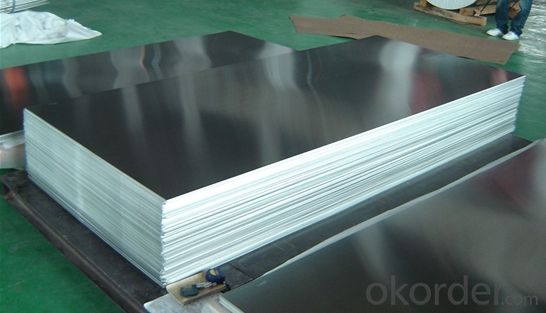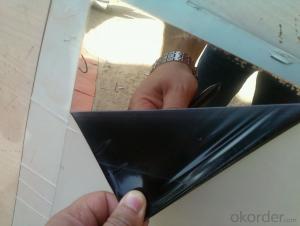Aluminium Cold Rolled And Hot Rolled Plate In Best Price
- Loading Port:
- Shanghai
- Payment Terms:
- TT OR LC
- Min Order Qty:
- 6 m.t
- Supply Capability:
- 200 m.t/month
OKorder Service Pledge
OKorder Financial Service
You Might Also Like
Item specifice
1.Structure of Product Description
Our aluminum sheet/plate/slab is widely used in the field of construction field and decoration field, etc.
There are many different grades, such as: 5000 series, 6000series, etc. The detailed grade are as follows: 1010, 1050,5052, 6061,6063,8011, etc.
The temper is include H24, H44,H112,H112, etc.
2. Main features of the product
a.Competitive price
b.Frist-Class Service.
3. Image.

4. Product detailed sizes:
1000mm*2000mm, 1250mm*2500mm,1500mm*3000mm, etc.
5. FAQ:
---Usually our standard is GB3880-2006 or others.
What is the width range?
---It is from 1000mm to 2500mm, etc.
What is the length range:
---It is from 2000mm to 6000mm, etc.
---Normally it is around 5 tons/each size.
How many tons did you export in one year?
---Singapore, Vietnam, Turkey,Canada, Fiji,UAE,etc.
---Normally they are aluminum sheet,mirror finish aluminium sheet, aluminum casting coil, etc.
- Q:Can aluminum sheet be used for heat exchangers?
- Indeed, aluminum sheet can be effectively utilized in heat exchangers. The utilization of aluminum as a material for heat exchangers is widespread owing to its remarkable thermal conductivity, lightweight nature, and resistance to corrosion. The remarkable thermal conductivity of aluminum facilitates the efficient transfer of heat between fluids, rendering it suitable for a multitude of heat exchange applications. Furthermore, aluminum is obtainable in diverse alloys and thicknesses, granting adaptability in design and customization to cater to specific heat exchanger prerequisites. On the whole, aluminum sheet emerges as a favored option for heat exchangers in industries encompassing automotive, HVAC, and aerospace.
- Q:Can aluminum sheets be anodized for corrosion protection?
- Aluminum sheets have the capacity to undergo anodization in order to safeguard against corrosion. Anodizing initiates an electrochemical reaction that generates a safeguarding oxide layer on the aluminum's surface. This protective oxide layer exhibits exceptional resistance against corrosion and provides a robust and enduring shield. Various aluminum products, including sheets, can be subjected to anodizing to elevate their resistance against corrosion, enhance their aesthetic appeal, and prolong their lifespan. The anodizing process entails immersing the aluminum sheet in an electrolyte solution and applying an electric current, enabling oxygen ions to bond with the metal's surface and establish the safeguarding oxide layer. Anodized aluminum sheets are extensively employed in vital industries such as aerospace, automotive, construction, and electronics, where corrosion resistance is of paramount importance.
- Q:What are some common applications of aluminum sheets?
- Due to their unique properties, aluminum sheets find a wide range of applications. Some of the common uses of aluminum sheets include the following: 1. Construction: Aluminum sheets are extensively utilized in the construction industry for roofing, siding, and window frames. Their lightweight nature and durability make them an ideal choice for these purposes. 2. Automotive industry: Aluminum sheets play a crucial role in the automotive industry, where they are used to manufacture car bodies, panels, and components. The lightweight nature of aluminum aids in reducing the overall weight of vehicles, thereby enhancing fuel efficiency. 3. Packaging: Aluminum sheets are widely employed for packaging, particularly in the food and beverage industry. Their ability to preserve the freshness and quality of packaged products makes them suitable for producing cans, foils, and lids. 4. Aerospace industry: The aerospace industry heavily relies on aluminum sheets for manufacturing aircraft bodies, wings, and structural components. This is due to their high strength-to-weight ratio, resistance to corrosion, and capability to withstand extreme temperatures. 5. Electrical industry: Aluminum sheets find various applications in the electrical industry, including the production of electrical enclosures, transformers, and bus bars. The excellent conductivity and lightweight properties of aluminum make it a preferred choice for these purposes. 6. Marine industry: The marine industry extensively uses aluminum sheets for constructing boats, ship hulls, and other marine structures. Aluminum's resistance to corrosion and ability to withstand harsh marine environments make it a suitable material for these applications. 7. Decorative purposes: Aluminum sheets are commonly utilized for decorative purposes in architecture and interior design. They can be shaped, engraved, or coated with different finishes to create aesthetically pleasing surfaces for walls, ceilings, furniture, and signage. These examples highlight just a few of the many applications of aluminum sheets. The versatility, durability, and lightweight nature of aluminum make it highly sought-after in various industries.
- Q:Aluminum alloy cable tray is made of a series of aluminum sheets, a series of pure aluminum aluminum plate can do?
- Do you fold it with aluminium plate? It should be about the same. The cold rolled aluminum of the 1 series is still a little bit stronger,I understand the shape of the material, and if the aluminum extrusion molding, direct use of 6063 is the most appropriate.
- Q:What is the typical electrical conductivity of aluminum sheets?
- The typical electrical conductivity of aluminum sheets is around 35.0 to 45.0 MS/m (mega siemens per meter) or 35,000 to 45,000 S/m (siemens per meter). Aluminum is known for its excellent electrical conductivity, which is approximately 61% of the conductivity of copper. This makes aluminum a popular choice for various electrical applications, such as wiring, power transmission lines, electrical busbars, and electrical equipment components. The conductivity of aluminum allows for efficient and reliable flow of electric current, making it a valuable material in the electrical industry.
- Q:Can aluminum sheet be used for heat sinks?
- Yes, aluminum sheet can be used for heat sinks. Aluminum has excellent thermal conductivity, making it a suitable material for dissipating heat. The sheet can be designed and fabricated into various shapes and sizes to effectively transfer and dissipate heat from electronic components or other heat-generating devices.
- Q:What does exterior wall imitate aluminium paint have? Imitate aluminium plate paint is fluorocarbon paint?
- Walls are generally used in fluorocarbon paint, Akesu Valspar KCC Nippon are international famous brand
- Q:What are the different methods of joining aluminum sheets without welding?
- There are several methods of joining aluminum sheets without welding. 1. Adhesive bonding: This method involves using an adhesive to bond two aluminum sheets together. The adhesive creates a strong and durable bond, and it can be applied in various ways such as tapes, liquid adhesives, or films. Adhesive bonding is a popular choice as it provides a clean and aesthetically pleasing finish. 2. Mechanical fastening: This method involves using mechanical fasteners such as screws, rivets, or bolts to join aluminum sheets together. These fasteners provide a strong and reliable connection and are commonly used in industries where disassembly or repair is required. Mechanical fastening is also relatively easy to implement and does not require any additional equipment. 3. Clinching: Clinching is a cold-forming process that involves joining aluminum sheets by using a punch and die to create a strong interlock between them. This method is suitable for thin aluminum sheets and offers good mechanical strength. Clinching is a cost-effective alternative to welding, as it does not require any additional materials or heat. 4. Friction stir welding: Although not technically welding, friction stir welding is a solid-state joining process that uses a rotating tool to generate frictional heat between the aluminum sheets. As the tool moves along the joint, it creates a plasticized region that is then consolidated to form a strong bond. Friction stir welding is mainly used for joining thicker aluminum sheets and offers excellent mechanical properties. 5. Folded joints: This method involves folding the edges of two aluminum sheets together to create a joint. The folded joint can be secured by using adhesives, mechanical fasteners, or a combination of both. Folded joints provide good strength and stiffness, and they are commonly used in applications where a seamless appearance is desired. These methods offer various advantages and can be chosen based on the specific requirements of the project, including the desired strength, appearance, and ease of implementation.
- Q:I have a project on the aluminum element. What are the advantages and disadvantages of this element?...What are the risks/dangers?...Thank you so much ---And please tell me where I could find this information too.
- Cheers Watch this video: A little boy bites his brother's finger - His brother's reaction is hilarious! F
- Q:Can aluminum sheets be used for insulation?
- No, aluminum sheets alone cannot be used for insulation as they have low insulation properties. However, they can be used as a reflective layer in combination with other insulation materials to enhance insulation efficiency by reflecting heat or cold.
1. Manufacturer Overview |
|
|---|---|
| Location | |
| Year Established | |
| Annual Output Value | |
| Main Markets | |
| Company Certifications | |
2. Manufacturer Certificates |
|
|---|---|
| a) Certification Name | |
| Range | |
| Reference | |
| Validity Period | |
3. Manufacturer Capability |
|
|---|---|
| a)Trade Capacity | |
| Nearest Port | |
| Export Percentage | |
| No.of Employees in Trade Department | |
| Language Spoken: | |
| b)Factory Information | |
| Factory Size: | |
| No. of Production Lines | |
| Contract Manufacturing | |
| Product Price Range | |
Send your message to us
Aluminium Cold Rolled And Hot Rolled Plate In Best Price
- Loading Port:
- Shanghai
- Payment Terms:
- TT OR LC
- Min Order Qty:
- 6 m.t
- Supply Capability:
- 200 m.t/month
OKorder Service Pledge
OKorder Financial Service
Similar products
New products
Hot products
Hot Searches
Related keywords





























